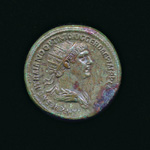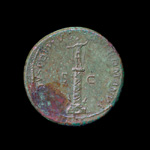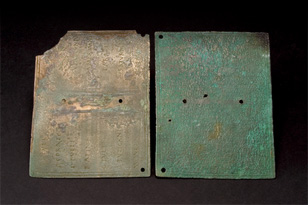The exhibition also features some bronze or silver coins from the first and second centuries AD. These objects display corrosion (rust and color variation) similar to that of the Roman diplomas.

Figure 2
The Emperor Trajan commemorated and celebrated his greatest conquests and achievements with images on coins that were struck during his reign. Several different coins glorified his conquest of Dacia with the inscription “Dacia Capta” and with images, such as of the amazing bridge that his army engineers built across the Danube River. One very scarce bronze sestertius [Figure 2] shows a radiate bust of Trajan on its front; on the back is Trajan’s Column in Rome, with eagles at its base [Figure 3].

Figure 3
Another Trajan coin on display shows, on its reverse side, the goddess Fortuna (Good Fortune) seated, holding a rudder and a cornucopia. These coins date to the same time as the military diploma of Marcus Herennius Polymitus.
Of the two silver Trajan coins on display, the larger one is a tetradrachm minted in Antioch, with a bust of Trajan with an eagle on the observe and a bust of Melgart, a local ruler, on the reverse. The smaller silver coin is a Trajan denarius; on its back is Concordia (Peace) seated before a lighted altar [Figure 4].

Figure 4
The denarius was a common Roman coin and was worth a day’s wages for an unskilled laborer. In the New Testament, the Good Samaritan gave two denarii to the innkeeper (Luke 10:35), and Jesus used such a coin when he told the chief priests and scribes to “render therefore unto Caesar the things which be Caesar’s” (Matt. 22:21; Mark 12:17; Luke 20:25).
Other coins come from the time of Tiberius Caesar, who was emperor during most of the life of Jesus. The small prutah, or widow’s mite, was struck in A.D. 29, during the time when Pontius Pilate was the prefect of Judea. The obverse reads “Julia Caesar,” with three ears of barley tied together; the reverse shows a libation with the words, “Of Tiberius Caesar year 16.”






